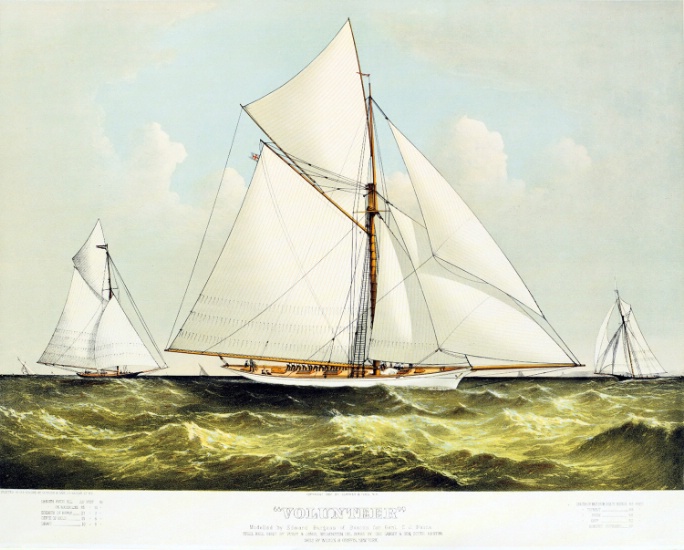
|
REF : 0
EDITION : 1887
DATE : 1887
COURSE : 0
DESCRIPTION SITE :
Chromium Lithograph on Paper
22-1/2" x 28 1/2" (57 cm x 72.25 cm)
The New York Yacht Club's cutter Volunteer; successfully defended the America's Cup in 1887 against he Scottish Challenger Thistle sailing for the Royal Clyde Yacht Club.
George Watson, then considered the most able English yacht designer, produced the challenger. Watson had been in the U.S. in 1886 taking notes on the best American Yachts. His design embodied the best features of the English Cutter, but with more beam for her depth; a cutter bow; and a cutaway stem.
Thistle's dimensions were: LOA 108.5'; LWL 86.46'; Beam 20.35'; draft 13.8; disp. 138T; sail area 8968 sq. ft.; racing measurement 89.2'. She had been of steel by Messrs. D.& W. Henderson; at Partick on the Clyde; and launched April 26; 1887.
In her trials Thistle defeated the best English racers; decisively beating the prior America's Cup challenger Genesta.
The Americans again selected their previously successful designer; Edward Burgess, who produced Volunteer, Boston's third successful Cup defender. Volunteer was built of steel by Pussy & Jones at Wilmington; Del.; and rigged by George Lawley & Sons in Boston.
Her dimensions were: LOA 106'3; LWL 85'10; Beam 23'2; Draft 10' (with centerboard up); 130 Ton displacement; 9271 Sq. ft. of sail area; and a racing measurement of 86.35' She was Burgess' fastest boat; considered a wonder in her time; and demonstrated her superiority from her first race. She easily defeated the previous defenders Mayflower and Puritan; and had a season's unbroken record of victories.
After a challenge was resolved over Thistle's having a LWL measurement of 1.46' more than her designer's specification; the racing began Sept. 27; 1887. With the wind averaging only 8 knots; and local knowledge helpful; Volunteer trounced Thistle by 19 minutes; 23 3/4 seconds. The second race (as shown in the painting) was on a windward/leeward course in 12 knots of wind with a considerable sea running accompanied by some rain. On the 20 mile beat the boats sailed with equal speed; but Volunteer demonstrated superiority by pointing higher and eventually won by 11 minutes; 48 3/4 seconds corrected time; even though Thistle was faster downwind. This decisively ended the best 2-out-of-3 contest. The beamier; lighter American centerboard design again defeated even the advanced English cutter.
Watson said Thistle's failure was because Her surface was so cut down that sufficient lateral plane was not left to hold her to windward and although she sailed as fast as the American champion; she drifted bodily to leeward.
LICENCE :
Public domain
| LIENS VERS CE DOCUMENT | ||||
| SITE | LARG | HAUT | ADRESSE | |
 |
Blue World Museum | 684 | 550 | http://blueworldwebmuseum.org/item.php?category=One-masted_Vessels&title=Cutter_Volunteer&id=91&catid=77 |